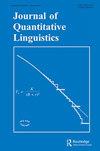自动分类中内部句法表征的判别性
IF 1.7
2区 文学
0 LANGUAGE & LINGUISTICS
引用次数: 6
摘要
摘要类型对文档的描述与大多数文档检索和分类应用程序关注的主题不同。这项工作通过在单词层面之外的功能和结构方面反思文体线索,假设句法变异和体裁分化之间存在密切的互动。它设计了14个内部表示的句法特征集,用于通过机器学习设备进行类型分类。实验结果表明,在体裁分类中,融合结构和词汇特征具有显著的优势(F∆max=9.2%,sig.=0.001),这表明结合句法线索进行体裁识别是有效的。此外,主成分分析报告称,名词短语(NP)是类型变化的最主要成分(66%),介词短语(PP)其次。特别是,具有介词补语主导结构的名词短语和充当主语的代词对于识别高形式的印刷文本最有效,而介词短语对于识别低形式的演讲则很有用。错误分析表明,短语特征对于四组类型类别的分类特别有用,即无脚本演讲、小说、新闻报道和学术写作,它们都以不同的结构特征分布,并且在语言复杂性的连续体中表现出递增的形式度。本文章由计算机程序翻译,如有差异,请以英文原文为准。
The Discriminativeness of Internal Syntactic Representations in Automatic Genre Classification
ABSTRACT Genre characterizes a document differently from a subject that has been the focus of most document retrieval and classification applications. This work hypothesizes a close interaction between syntactic variation and genre differentiation by introspecting stylistic cues in functional and structural aspects beyond word level. It has engineered 14 syntactic feature sets of internal representations for genre classification through Machine Learning devices. Experiment results show significant superiority of fusing structural and lexical features for genre classification (F∆max. = 9.2%, sig. = 0.001), suggesting the effectiveness of incorporating syntactic cues for genre discrimination. In addition, the PCA analysis reports the noun phrases (NP) as the most principle component (66%) for genre variation and prepositional phrases (PP) the second. Particularly, noun phrases with dominant structures of prepositional complements and pronouns functioning as a subject are most effective for identifying printed texts of high formality, while prepositional phrases are useful for identifying speeches of low formality. Error analysis suggests that the phrasal features are particularly useful for classifying four groups of genre classes, i.e. unscripted speech, fiction, news reports, and academic writing, all distributed with distinct structural characteristics, and they demonstrate an incremental degree of formality in the continuum of language complexity.
求助全文
通过发布文献求助,成功后即可免费获取论文全文。
去求助
来源期刊

Journal of Quantitative Linguistics
Multiple-
CiteScore
2.90
自引率
7.10%
发文量
7
期刊介绍:
The Journal of Quantitative Linguistics is an international forum for the publication and discussion of research on the quantitative characteristics of language and text in an exact mathematical form. This approach, which is of growing interest, opens up important and exciting theoretical perspectives, as well as solutions for a wide range of practical problems such as machine learning or statistical parsing, by introducing into linguistics the methods and models of advanced scientific disciplines such as the natural sciences, economics, and psychology.
 求助内容:
求助内容: 应助结果提醒方式:
应助结果提醒方式:


